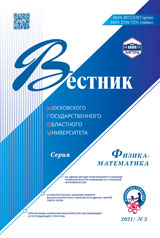
The scientific journal “Bulletin of Federal State University of Education. Series: Physics and Mathematics” has been published since 1998 and is a peer-reviewed and subscription publication that is in demand by the scientific community. Since 2012, the journal has been included by the Higher Attestation Commission of the Ministry of Education and Science of the Russian Federation in the list of peer-reviewed scientific journals and publications.
The journal publishes the results of scientific work on the issues identified by the Higher Attestation Commission in the passports of the following scientific specialties: 1.3.3. – Theoretical physics (physical and mathematical sciences) and 1.3.8. – Condensed-matter physics (physical and mathematical sciences).
The journal is published four times a year.
Bulletin of State University of Education. Series: Physics and Mathematics is distributed by subscription. The subscription index of the journal in the United Catalog "Press of Russia" is 40723.
The quality of publications in the journal is ensured, in particular, by established strict peer review activity criteria. The review procedure is determined by the “Regulations on the scientific journal “Bulletin of State University of Education. Series: Physics and Mathematics”, available at the journal website. The authors are provided with a detailed review or a reasoned rejection for publishing.
Bulletin of State University of Education. Series: Physics and Mathematics has a full-text online version on the platform of the Scientific Electronic Library (www.elibrary.ru) and promptly provides information about published scientific papers. The RSCI website and the journal website provide the readers with free access to full texts of the papers published in the journal.
The editorial and publishing board of Bulletin of State University of Education. Series: Physics and Mathematics includes well-known scientists representing various branches of science from the Lomonosov Moscow State University, Moscow Institute of Physics and Technology, Peoples' Friendship University of Russia, Moscow State Pedagogical University; State University of Education and other organizations.
































